Yoguely is reader-supported. When you buy through links on our site, we may earn an affiliate commission. Learn more
How I Got 7 NASA Internships (Proven Winning Formula)

In today’s post I’m going to show you exactly how to get a NASA internship.
In fact, this is the exact process I used to secure 7 VERY competitive NASA internships which led to a NASA full-time job offer.
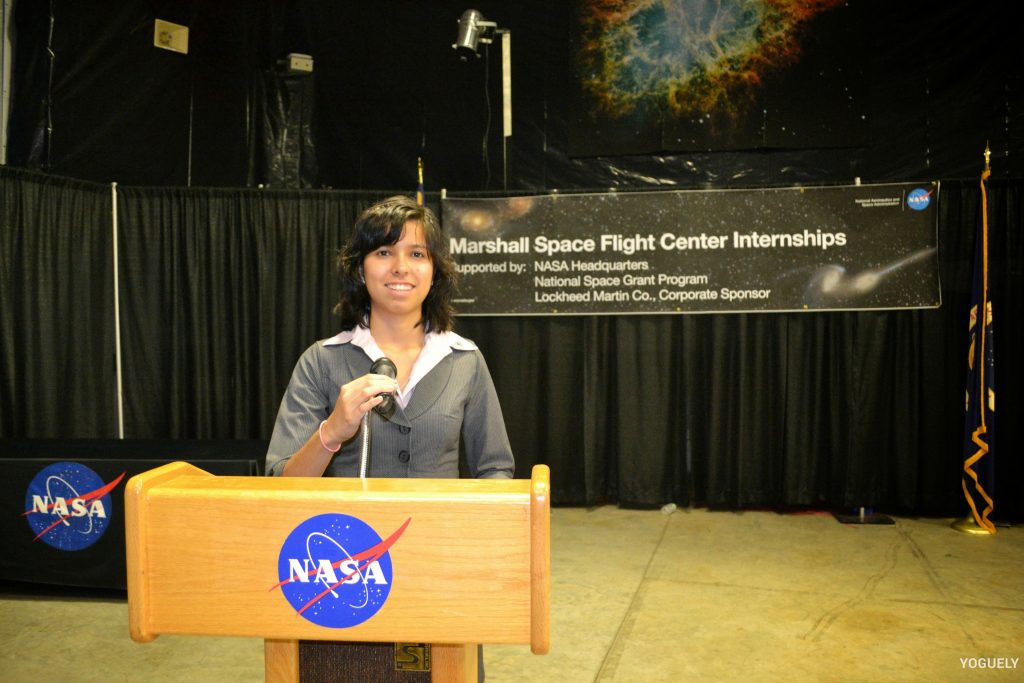
And today you’re going to see step-by-step, how I accomplished it.
Let’s get started.
How I Stood out Among Talented Engineers (And Landed 7 Jobs at NASA)
Getting a job at NASA is WILDLY COMPETITIVE.
Just think about it:
Many aspiring engineers in the world want to work inside NASA.
And I’m just one woman competing against students from top ranking universities like Massachusetts Institute of Technology, Stanford University, and University of California Berkeley.
I’ll be honest with you:
I wasn’t sure that I’d be able to stand out among these bright students for such a competitive job.
But thanks to the process I’m about to share with you, NASA quickly made me an offer for my top choice project.
And today, I have 7 internship experiences at 5 different NASA space centers.
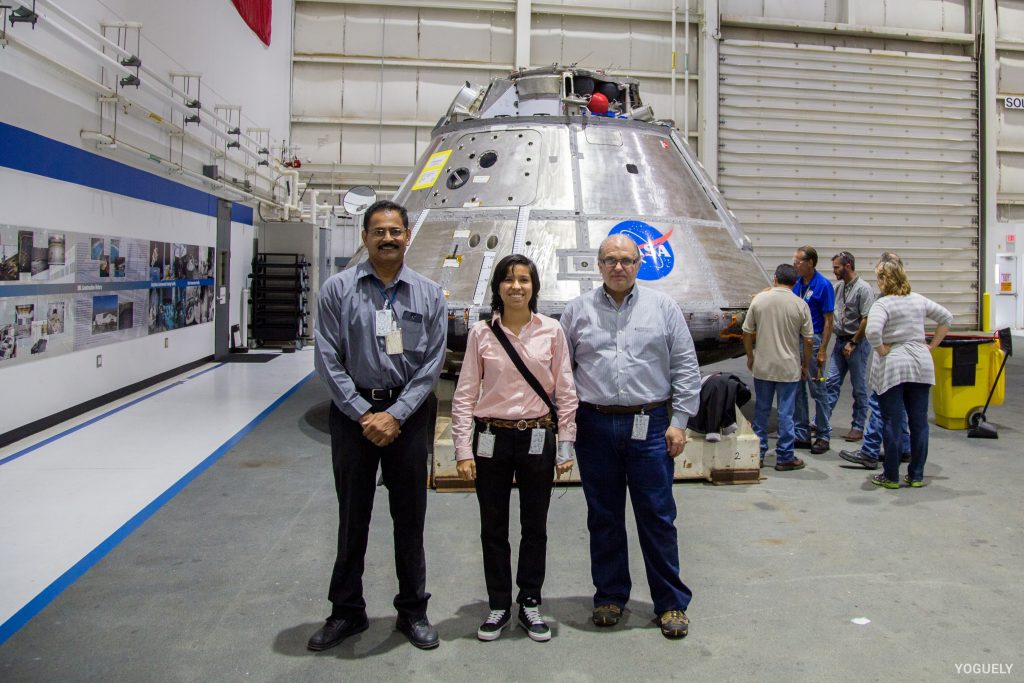
Aida Yoguely working at the NASA Johnson Space Center as a civil servant.
Alright, back to now.
It’s about time for me to show you how I got it done.
Step #1: Pick an Application Timeline to Follow
Contacting anyone at NASA is easy. When and how to do it is the tricky part.
NASA has three work sessions you can choose from: spring, summer, or fall.
Summertime is the most competitive and crowded since most students will take this time off school to gain real world work experience.
Fall and spring are a pretty desolated period for interns. So many spots will sometimes go unfilled during this time.
Which gives you better chances of filling one of those spots — if you meet the job description.
The application timeline for NASA internships runs a whole season before. (e.g. December to March for a summer internship)
Jump into the application timeline too early (December), while mentors are still putting up their listings, and there won’t be much to choose from.
Jump into the process too late (February), and most spots will be filled.
What is the best time to apply?
Here’s is an untold secret about the NASA selection process that I learned from the inside:
Mentor’s do not wait until past the deadline to choose their interns.
Mentors understand that getting a student passed bureaucrats is a time consuming process, so they start early too.
Not only that, but also there are certain students who, as part of scholarships and programs, need to be placed somewhere within the space center.
Therefore mentors are given this priority list of students to look through first.
That’s why I always completed my application profile at least two months before (January) the original deadline. Which by the way tends to get extended if there aren’t enough applicants.
It is also the reason that as soon as I hit the submit button on my application, I began reaching out to NASA personnel.
How long does it take to hear back from NASA?
It depends. There is no knowing for sure when you might hear back. The sure thing though is that you will only be notified if you get an offer.
For me, being proactive sure payed off.
A month after I had begun contacting NASA personnel (by the end of February), I received an email from NASA with my offer letter.
I repeated this strategy again, and again.
And year after year, I would secure my offer letter 4 weeks later (by the end of February.)
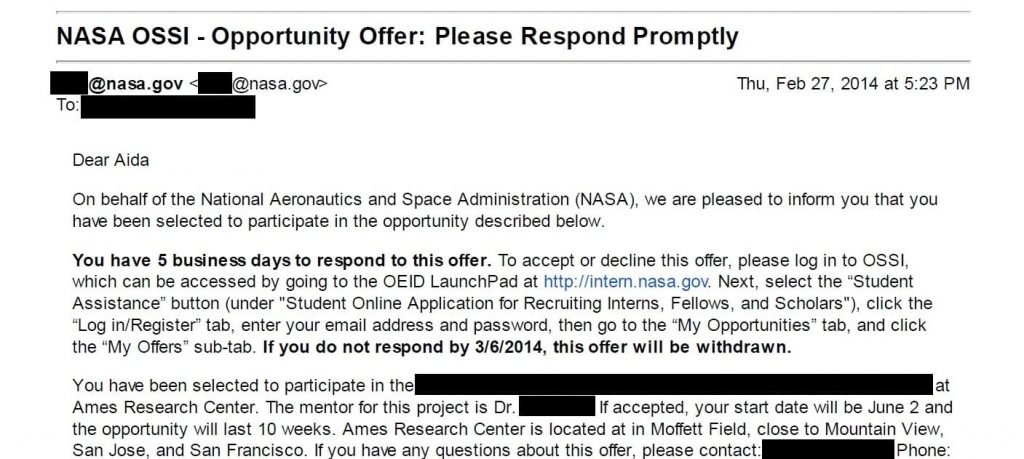
OSSI was an overly-complicated acronym that referred to the online intern application system.
This was no coincidence.
Now let me show you what chips you need in place to have a successful outreach.
Step #2: Complete Your Application Profile Before Making Contact
A mentor will be more likely to take you seriously and respond to your inquiries if they can see your profile in the online application system and your selected availability dates.[5]
Your profile tells them that you qualify. Plus, they can view your skills, essays, transcripts, and letters of recommendations before responding back to you.
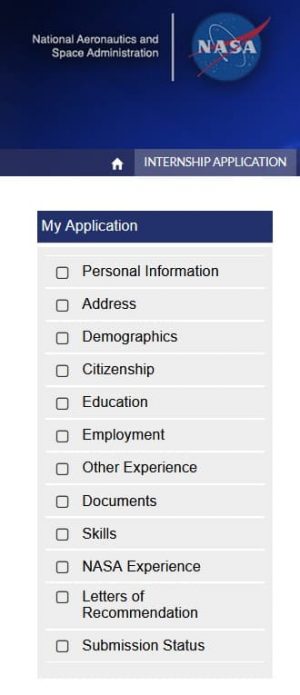
Completing your application profile actually opens the door for any mentor to reach out to you if they think you are a good candidate for the job.
Once my application was in the system, several NASA mentors began to contact me for jobs postings I had not yet applied for.
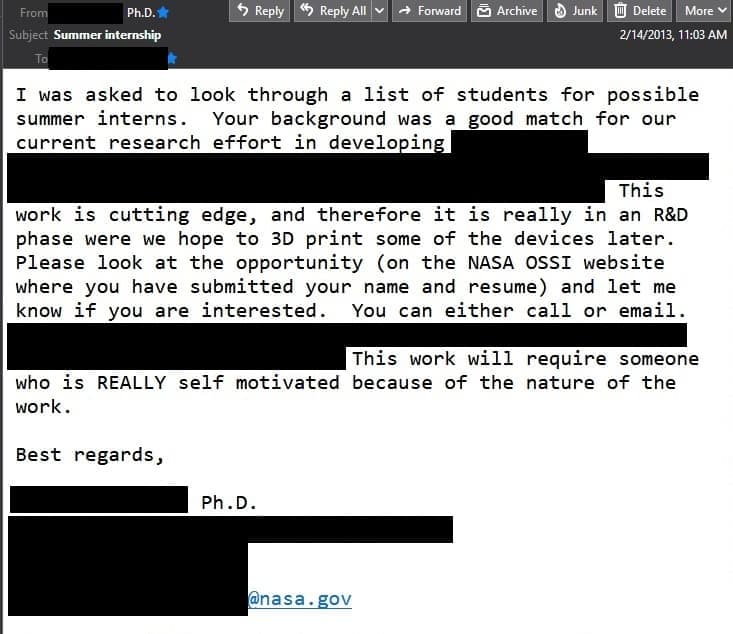
To which I replied:
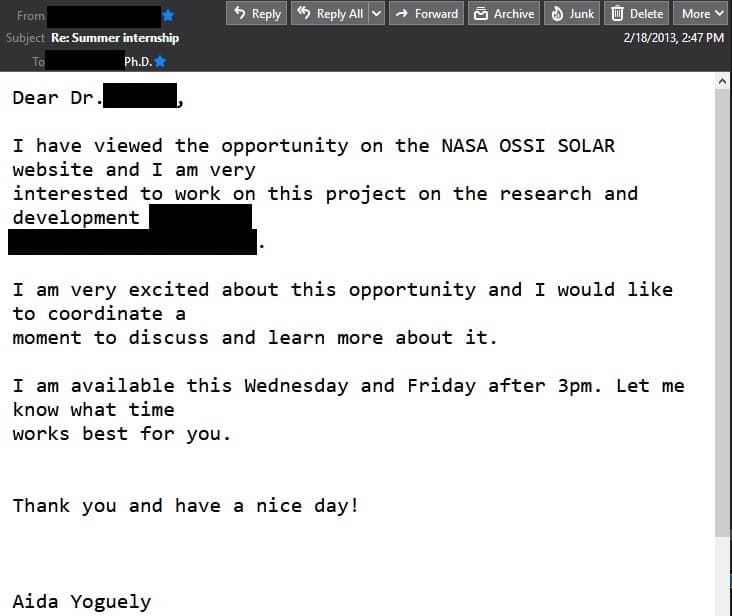
It was overwhelming. But satisfying.
That comes to show the benefit of applying early.
So submit your application before you contact companies.
Step #3: Identify a Job You’d Like to Do
Every season NASA posts several short-term job listings online for full-time students from high school, undergraduate level, and graduate school.[6]
If you are looking to go straight to a full-time job, skip to here.
You could be pursuing virtually any degree, as NASA is an organization that has a huge variety of work that needs to get done.
To name a few, there’s: engineering, science, journalism, multimedia, social media, public affairs, accounting, history, Cybersecurity, business, education, management, and legal administration.
They like to call them “opportunities”, “competitive awards”, and “projects”
This is for two reasons:
The first is that some of them are unpaid jobs, which they call “volunteer opportunities.”
Beware of those.
The second is that, doesn’t the word “opportunity” sound so much more fun and rewarding than the word “job”?
It’s subconscious marketing in plain sight.
They are trying to sell themselves to you, so that you choose them over other companies.
But rest assured! These listings are indeed short-term jobs, known as internships.
Note that applying through the NASA intern website gets you a contractor position, so you won’t be sworn-in as an official Government employee.
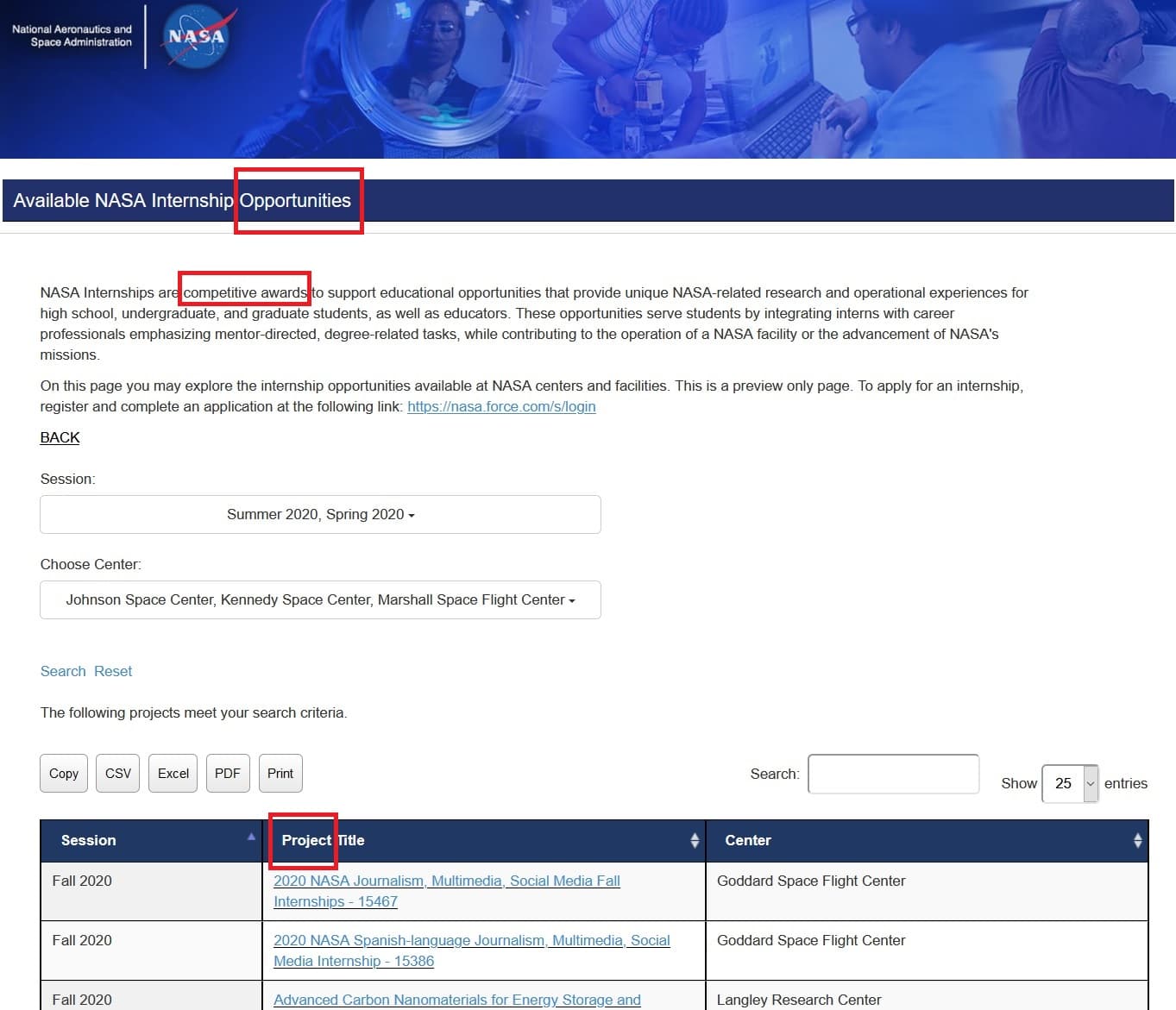
Identify a job that accepts your current academic level, major, and skills. Lastly, select the one you think you would enjoy working on 40 hours a week.
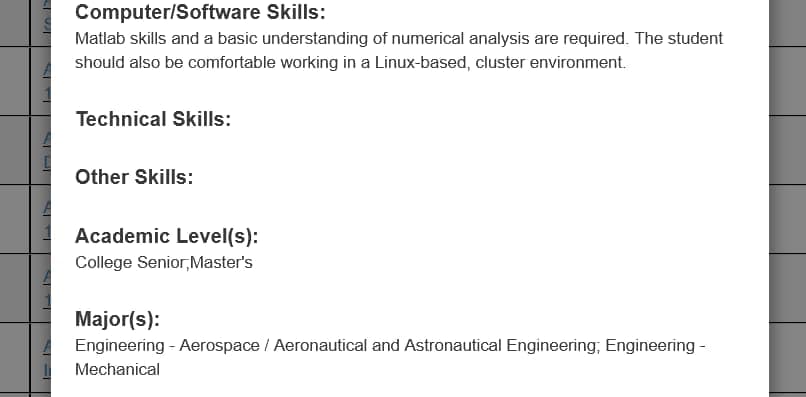
How to Work for NASA as a Civil Servant
If you are a student looking to convert your NASA experience into a full-time job offer after you graduate, then look into the pathways program through the US government’s site for civil service job listings.[7]
If you are not a student anymore and you are already in the work-force, then USAJobs is the place you’ll want to visit to find civil servant jobs at NASA.
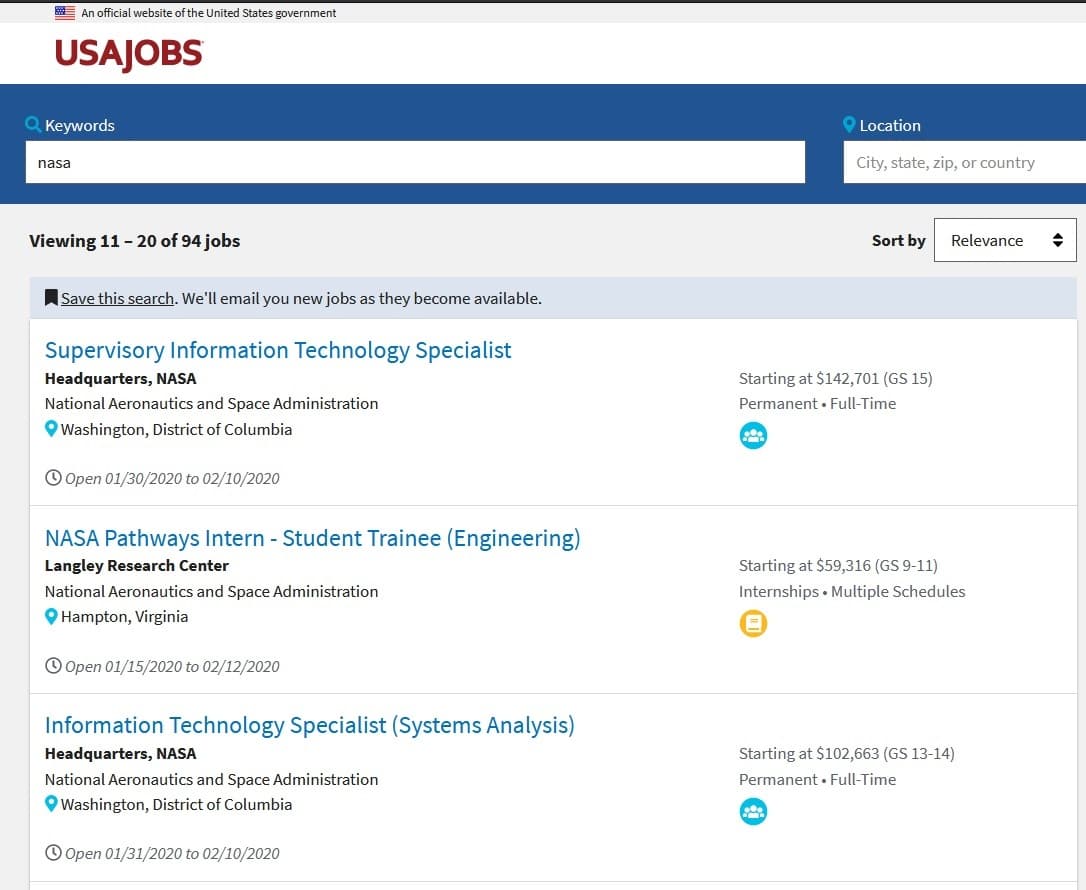
At USAJobs, positions opens sporadically all year long. For instance, it could be open for 48 hours or for 3 days.
So what I did is create an account there and sign up for email notifications for anything that matches the keyword “NASA.”
If you are applying through USAJobs, then the process to secure the job is simple: apply, wait to get past through the system’s filter, complete an interview, and receive your offer letter.
The focus is to make the filter decide your are a good fit for the next stage. You achieve this by strategically including keywords that matches the job description and your set of skills and experiences.
There is no need to overthink it. Use exact keyword matches and then feel free to use synonyms as you wish.
By the way, you’ll receive an email if you don’t get past the filter.
Federal agencies are very strict about following the selection process for civil servant positions. So networking will not give you any advantage or preference in getting through the automatic filter.
This is how I got into the graduate pathways program (Co-op) as a civil servant, and then got my full-time job offer at NASA.
How to Work at NASA as a Contractor
Another alternative if you want to work at a NASA location but not for NASA itself, is to seek out work as a contractor.
There are a TON advantages to not working directly with NASA.
For instance, the private sector generally has higher pay. Plus salary promotions are open to negotiations as opposed to being rigidly based on time — the General Schedule (GS) Pay Scale.[8]
You can start by looking at the list of NASA contractors,[9] and then sorting by the top contractors of the U.S. federal government.[10]
Step #4: Get Insights on the Team
In order to have a productive conversation with a mentor, you need to know as much as you can about the tasks and the team.
The more familiar you are with the needs and goals of the group, the more likable you will be.
It will feel as if you are already part of the team.
Scour the web using the info provided. Enter the project title, description, building and room number into search engines.
Find the following information:
What division and branch is involved in the project? What is their mission?
Who are the people behind the project?
You can find out who are their bosses, who’s the Head Engineer, Chief Engineer, and Director by using this handy search string to find them:
- “Company” + “Division Name” + “Org Chart”
This will pull up the organizational chart which shows how all the job positions are structured, related, and ranked to each other in a hierarchical fashion.
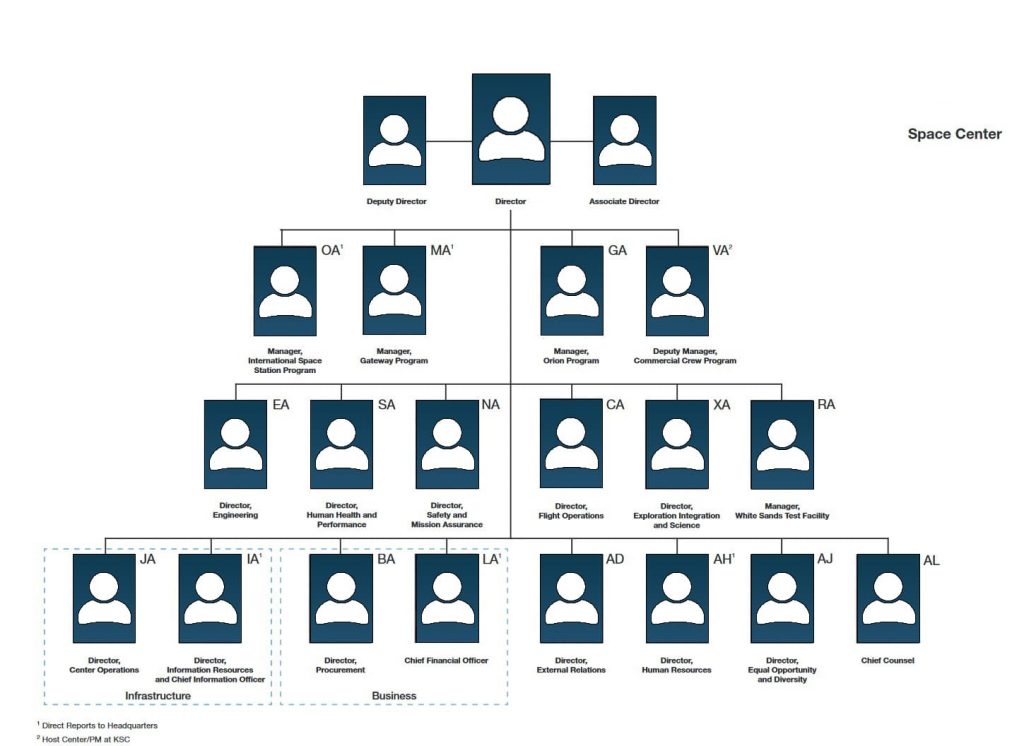
Example of what an Organizational Chart could look like.
Then use linkedin to find those people’s résumé. Get a feel for what it would be like to spend a 40 hour work-week with them.
Do they spend a lot of time standing in a lab, coding on the computer, or sitting in meetings?
By now, you may have a hint of who might be the mentor for that project.
Study their career path, and ask yourself: Would their advice and expertise help me achieve my career goals? Is this a path I would like to follow?
But what if I don’t find any information online?
We can speculate on the possibilities. Perhaps the project is fairly new. They don’t have much funding, are on the early research stages, or they haven’t had any PR worthy accomplishments yet.
This may be a warning sign. After all, the more buzz there is around a project, the cooler the story will look on your résumé.
Why?
Because it translates to having worked on a project with meaningful real-world applications. It means having worked side-by-side with a mentor who can drive cutting-edge results.
An intern working on an interesting topic can only get so far. But an intern working with a great mentor, a great team, that’s when innovation can happen.
Faster alone, further together.
And that’s what you want.
To be able to say that you spent a two-month summer internship working with experts, you gained marketable skills, and you accomplished something important.
You could be that intern who discovers a new planet.[1]
You could be that intern who develops the next generation super-capacitors and replace every heavy battery on Earth and in space with it.

Aida Yoguely during her summer internship at the NASA Marshall Space Center. Developing the next state-of-the art ultracapacitor to replace batteries.
Step #5: Reach out to Former Employees
Not all internships turn out for the better. Sometimes your mentor’s management style clashes with your work style.
It’s hard to get a feel for this reading résumés. Even employers know this. Which is where a letter-of-recommendation comes in handy.
Think about it:
You are required to send letters from your previous employers recommending you as a good employee.
However the contrary doesn’t happen. Mentor’s aren’t required to prove to you that they are great mentors.
Being a good mentor, being a great manager, is a skill that takes practice. And trust me, not everyone has the training.
To watch out for yourself, you’ll need to think like a business.
You are the CEO of your life, investing your valuable time and energy. But it’s only an investment if you are sure that it’ll pay off. Otherwise, your are just speculating.
Let’s make sure it’s worth it.
Acquire the contact information of previous interns to get first hand experiences of what employment with that company was like, what it was like to work with that mentor, and what they gained from it.
This is the information age after all, use it to your advantage.
Find former interns of that team by using this handy search string:
- “Company Name” + “Project Title” + “Intern”
They might appear on news articles, blog posts, or even on the company website.
Knowing their first and last name, use social media (like linkedin) to find out what school they go to.
Then use this search string to get to their school’s directory:
- “School Name” + “Directory”
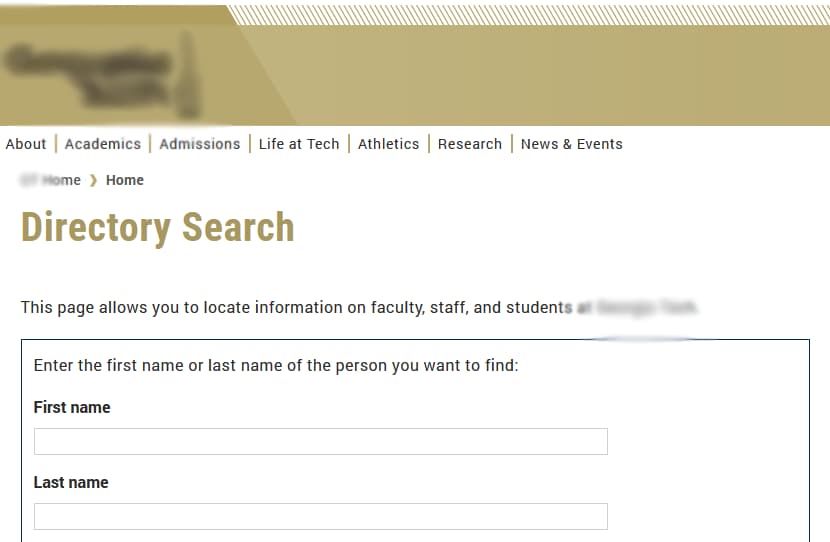
Input their name into the directory search and voilà! You’ve got their email address!
Email Template to Contact Former Employees
For me, my inbox is my to do list. And I’m a busy person, so the first 3 things my brain wants to know when I hear that “You’ve Got Mail!” notification is:
- Who is this?
- What do they want?
- How long will this take?
So tick off all 3 right away in the email header.
Then expand upon them in the body of your email.
Mention only the bit of information you are sure of. It could be the project title, the branch or division, or more specifically, the Mentor’s name.
Here’s an example of a script:
Subject: 3 Quick Questions on Your [Company] Experience with [Mentor’s name]
—
Dear [Former intern’s name],
I was searching for some information on [project title] when I came across this article “[Title of the article]” ([Link to the article]) where I read about your experience working at [Company] with [Mentor’s name].
Great stuff!
I especially liked that [Personalized praise].
Currently, I am a [Degree] student from [School Name]. I am applying for [Company] internships and am interested in working with that same group. I was wondering if you could tell me a little more about your experience:
What was it like working with [Mentor’s name] at [Company]?
What did you liked & disliked the most about working with this mentor?
Would you work with this mentor again if you had the chance?
Either way, keep up the good work.
Thank you and have a nice day!
[Your Name]
The better your internship experiences go, the higher the chances you’ll nail that full-time position you want later on.
A few notes about this script:
- The idea of this script is to establish contact, tell them who you are, how you found them, and ask them questions.
- Keep the number of questions down to your top 3 for a quicker response time.
- The most revealing question appears to be “Would you work with this mentor again if you had the chance?”
Questions for Former Employees
If this email sparks a conversation, you could dive in to more specific questions that could help you decide if you want to pursue that particular job posting like:
- How many interns do they manage at a time? I.e. Were you the only intern in the group or were there many interns?
- What was this mentor’s management style like?
- Was this mentor hands-on or hands-off during the project?
- How often did you schedule meetings together?
- How accessible was this mentor for communicating?
- How was constructive feedback handled throughout the project?
- How was the work pace of the project? I.e. Slow and stagnant, fast pace and productive.
- What were the outcomes of the experience? Did you acquire any awards, patents, published papers, posters, talks, conference travel opportunities?
- Would you recommend this mentor to others?
After you’ve gotten responses, you’ll realize a quite relieving fact:
Not Everyone Wants to Work for NASA
The hype you’ve gathered from the news and propaganda is the work of the NASA Public Affairs Office.
Actually physically working there is a whole nother picture. It’s a picture you can get from people who’ve worked there and by working there yourself.
Here’s the good news:
You have a way better chance of landing that job posting than you initially thought at the beginning of this article!
So give it a try! Move on to the next step.
Step #6: Apply for an Internship
Once you’ve found a job listing that fits you well and has promising outcomes, update your application by implementing keywords from the job description that matches your skills and experiences.
Then go ahead and submit your application directly to it through the online application system.[5]
The NASA mentor is immediately notified of your application, and knows you exist.
So you applied for a NASA Internship, what now?
Many of you people sent me messages inquiring “What do I do after submitting the application?”
This one in particular caught my attention:
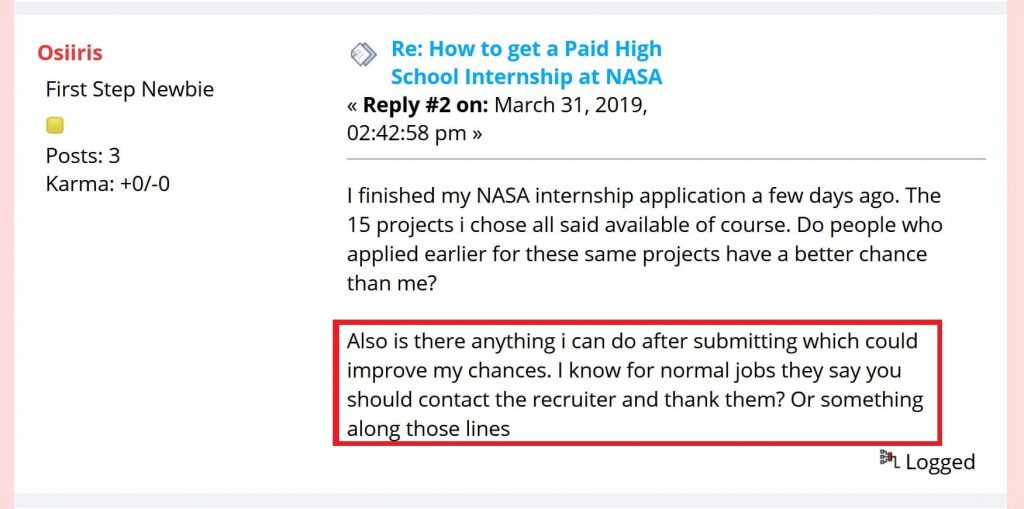
Notice that the student seems to associate a NASA internship as not a “normal job.”
To which I replied:
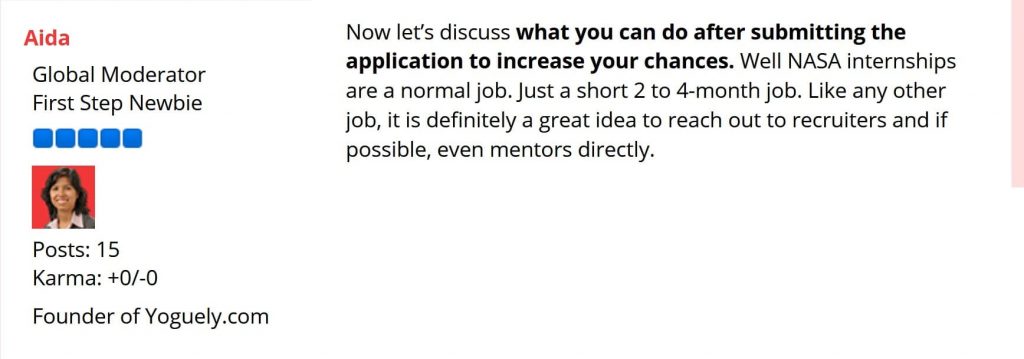
More of you are asking how to go about doing it:
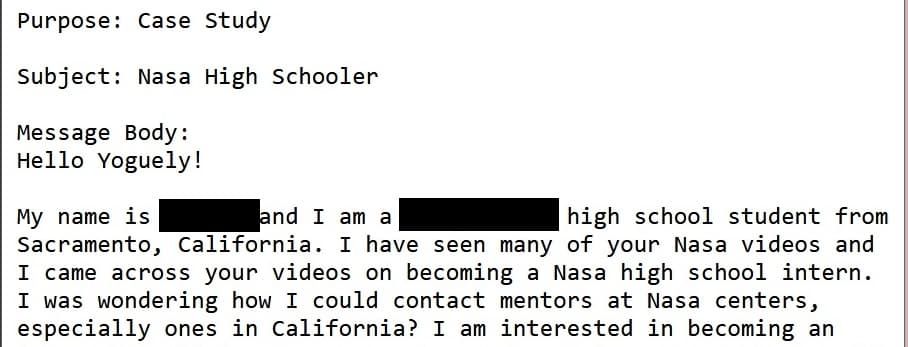
Ask and you shall receive. Because of your questions, this blog post was born.
You won’t find in the NASA FAQs any encouragement to reach out to NASA personnel if you are interested in a particular project.
But within NASA it is well know that communication is a strong factor in sealing the deal for any job hunt.
After your application is in, it’s crucial to get in touch.
At this point you’ve made 75% of the effort required to secure the job. Same as the majority of applicants.
This is where most students stop. Especially students who are applying to a dozen other job postings simultaneously.
Why get so far to stop now?
Be active. Push the last 25% to take your application to the next level.
Why is Reaching Out to Hiring Managers So Important?
Have you ever immediately dismissed an ad when it’s a brand you don’t know? But when you saw the brand for a second time, you thought “Hey this look important!” You stopped what you are doing, and actually tried to understand what they offer before eventually closing it.
Until one day you see the brand at a store and you yell “Oh, I’ve seen them before! I know what these are good for!” Then you rush to buy the product thinking “This must be good.”
You’ve got to stand-out and make people want what you are selling — yourself.
A way to do that is through a cognitive bias. A bias that affects everyone, even super educated and experienced professionals.
The “Ambiguity Effect”, that is the tendency to lean towards the familiar and avoid options that are unknown.[2]
Touching base with recruiters gives you an opportunity to explain why choosing you would lead to a favorable outcome.
While algorithms filter qualified applicants, it’s ultimately a human who chooses the winning candidate.
From a recruiters point of view, they feel nervous, it’s not a clear cut straight forward choice.
When it comes down to you and another similarly qualified applicant, what’s going to be the deciding factor?
Whether those skills on paper, can generate real-world results. Since this is a mere probability, you’ll need to make them feel confident that you can.
The best way to get your message through is by directly contacting the hiring manager.
You could be the most technically specialized engineer. But if you lack the interdisciplinary knowledge of sales and marketing, another qualified and highly sociable character could take the spot.
But don’t worry, I’ll teach you how to send emails that’ll make recruiters remember your name.
Step #7: Find Your POC
At NASA, the HR (Human Resources) folks in charge are called internship program coordinators. They are your point of contact (POC) moving forward.
As a matter of fact, they exist to help match students like you with mentors at NASA. Each space center and facility has one.
Their contact information is floating online. For example, the NASA Jet Propulsion Laboratory’s (JPL) site displays the contact info for their internship program coordinator.[3]
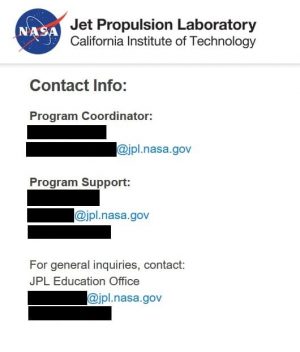
Step #8: Find Your Contact on the Directory
Mentors are the hiring managers, the one’s who created the job position. Just like a recruiter, mentor’s are the ones who review your résumé. So the goal is to get your résumé into their hands.
If you completed step #4, you may have an idea of the mentor’s name for the project you are interested in.
However, it is possible that someone else is taking over as mentor. If you are not 100% certain, then focus on reaching out to your POC first. They will help connect you to the right person.
Either way…
Finding contact information of NASA personnel is really easy. Here’s how:
NASA, being an agency of the US Federal Government, has a site where you can search agency-wide for anybody. All you need to know is their name, email or phone number.
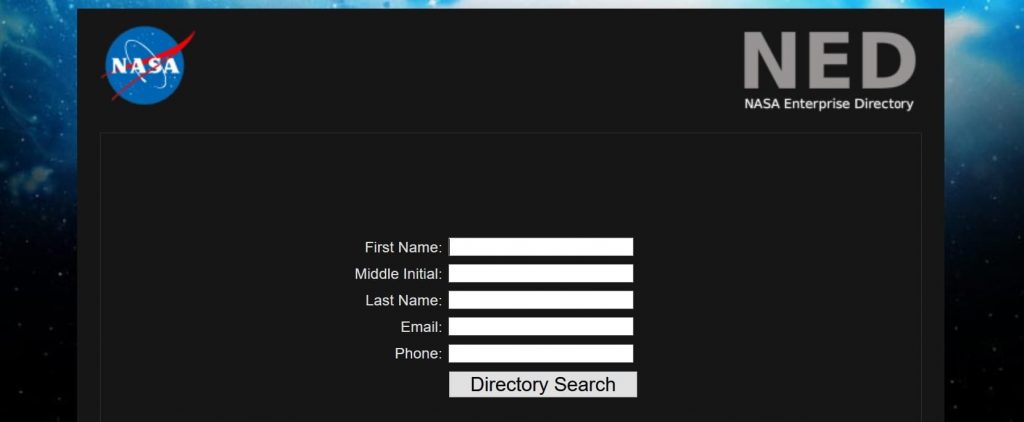
It’s called the NASA Enterprise Directory (NED).[4]
Use it to search the NASA directory for your contact.
The best part?
You can find the work phone and email for anyone: NASA engineers, scientists, and even astronauts!
But don’t be so quick to contact them yet! You only have one chance to make a first impression.
Although the website gives you phone numbers, do not cold call employees. It puts them on the spot at an unwelcoming time.
Instead, take a professional approach.
Send them an email and arrange a phone call. This gives them time to prepare for the meeting and prevents you from giving an awkward first impression.
OK so you got the email address for your POC at the work location you’ve applied to.
Now, what do you write in the email?
Keep on reading to learn how…
Step #9: Contact Them for a Job
Your next step in contacting a company is to touch base with your POC and leave a lasting impression.
Now I’m going to show you techniques that almost guarantees that you get fast responses from every email that you send.
Here is a breakdown of the elements for a well written cover letter:
- Include an attention grabbing introduction.
- Show how you can solve their specific problem.
- End with a tenacious call to action (CTA).
Include an Attention Grabbing Introduction
An incredibly powerful thing to mention in your first sentence is a referral from someone in your contact’s network.
The recipient would think:
“If someone I respect sent you my way, then you must certainly be worth my time.”
Which will lead them to read your next sentence instead of sending you straight to the junk box.
But how can you acquire a referral if you don’t know anyone?
There is no way around it. You gotta put in the work.
Time to start networking, making connections, and getting involved. Talk to professors at school, participate in student organizations, go to conferences, and gain company contacts by becoming part of other company educational programs.
Eventually, you’ll meet someone influential. And once they know you well, they can vouch for you.
Show How You Can Solve Their Problem
Since this is the first time reaching out to the company POC, assume they don’t know anything about you, even though you’ve applied online.
The email itself will be a job application, where the body is your cover letter and the attachment is your 1 to 2 page résumé.
What you write to the company contact should justify why you are a good fit for them, and they are a good fit for you.
So no begging, value yourself. Be bold and speak with confidence.
Here’s how you craft an intriguing letter:
Make it Clear and Concise
Don’t overload your contact with information on your first email.
Nowadays less is more.
An email that doesn’t take much time to make a memorable point, will be way more effective than those that drag on.
Interestingly, the approach to writing an effective cover letter is similar to writing an advertisement:
Every Word Counts
Which is where copywriting skills, come in handy.
Focus on your highlights, simplify what you are offering to them: your skills, experiences, and your capability to get work done.
That’s right.
Keep in mind that your first outreach email will be sent to the company POC.
Which means that your target audience is someone from the HR department that doesn’t know jack about your specialized field.
So save the technical terms, jargon, acronyms, and fluff for your conversation with the mentor.
Yada-yada-yada. Avoid listing ALL your skills. It’s empty and meaningless.
But, how do you overcome having a boring list of keywords?
You need to make your company POC feel smart. After all, feeling smart makes you feel good doesn’t it?
If your contact doesn’t fully understand what you are selling to them, it could scare them away.
So do this instead:
Focus on Results
Directly inform the company POC of what quality of work they can expect from you. To do this, include a case study. Which is a solid example of the results from your achievements.
For example, If your achievement was,
“Optimized the mechanical design to reduce material and complexity.”
Then your result is,
“I saved the company 100 thousand dollars annually in production costs.”
Whoa!
That sounds impressive. Now your talking my language!
Your result is the meaning behind it, it’s the big picture of how your work was useful to them.
It’s the words that creates a strong desire for you. It’s the chance to make your audience, your point of contact, feel as though you can fill their needs.
Now that you have an idea of the kind of energy the email must convey, it’s time to end it with a bang.
End With a Tenacious Call to Action (CTA)
Your email should make them hungry to know more, to want to schedule a phone interview with them.
So write a strong ending that tells the recipient exactly what to do. Then make it easy for them to reach you by providing your phone number.
Make sure your voicemail is set to something decent.
And lastly give them a time frame of when you will be touching base again if they haven’t responded.
This will create a slight sense of urgency and pressure to reply before you poke them again.
Email Template to Contact Anyone for a Job
Here is what the cover letter looks like after incorporating all the elements.
Personalize this script before sending it their way:
Subject: [Company] Internship: [Job listing]
—
Dear [Company POC],
I was referred to you by [Referral], the [Referral’s job title], who informed me that the [Company Location] is actively seeking to hire quality individuals for your [company program title].
Currently, I am a [Degree] student from [School name]. Recently, I’ve submitted my application online to [Job listing] and would like to get in touch with the mentor for this position. I have [Your results-focused work experience]. [Why you are prepared for this job].
I am interested in [Keywords from the job description].
[Reason why you want to work for them]. Please call me at [Your Phone Number] to arrange a convenient time when we may meet to further discuss my background and qualifications.
If I have not heard from you, I will follow up within a week to secure an interview meeting date and time. I look forward to speaking with you soon.
Sincerely,
[Your Name]
[Your Degree Level]
[Your Major]
[Your School]
[Your Phone Number]
Now you just gotta wait until you see NASA in your inbox or on your caller ID.
Step #10: Schedule an Interview
I received replies from NASA within days using this strategy. It works!
Having my chips in place first AND THEN reaching out to NASA with my cover letter and résumé was what made this outreach execution a successful one.
Afterwards, the POC would put me in touch with the NASA mentor and then I’d coordinate a meeting via phone or webcam.
What comes next to secure the job is for you to impress them during your interview questions and for you to get to know the mentor.
Then send a followup thank you message and wait patiently. If they send you an offer, carefully review it against all other offers.
Keep in mind that once you begin to specialize in a certain area, your résumé will make it easier to get more of that kind of job. But unfortunately, it will also make it much harder to take on a whole new career path.
Look into the differences between long-term salary and promotions among various companies. And keep in mind that NASA is subject to constant budget issues which leads to unstable paychecks.
Conclusion
There you have it folks. That’s my step-by-step guide to get a NASA internship.
If you’d like me to dive into those topics or any other, let me know in the comment section below. Or join the discussion in the Yoguely Community Forum.
Join our newsletter to get the latest content straight to your inbox.
I’m Aida Yoguely. Thanks for learning with me today. And I’ll see you next time. That’s all folks!
Video
Be sure to subscribe and hit the notification bell to stay tuned for the latest videos.
References
Thumbnail background Image Credit: NASA
1. ^ “NASA Intern Discovers New Planet“.
2. ^ “Ambiguity Effect“.
3. ^ “NASA Jet Propulsion Laboratory (JPL) internship program coordinator“.
4. ^ “NASA Enterprise Directory (NED)“.
5. ^ “NASA online application system“.
6. ^ “NASA short-term job listings“
7. ^ “civil service job listings“
8. ^ “Lyndon B. Johnson Space Center Salary Statistics“
9. ^ “List of NASA Contractors” . Wikipedia. Retrieved 19 February 2019.
10. ^ “Top 100 Contractors of the U.S. Federal Government” . Wikipedia. Retrieved 19 February 2019.
- Why Helicopter Money Is Inflationary - 2021-10-09
- How Interest Rates Affect Inflation - 2021-10-08
- How Long Has Inflation Existed? - 2021-10-01

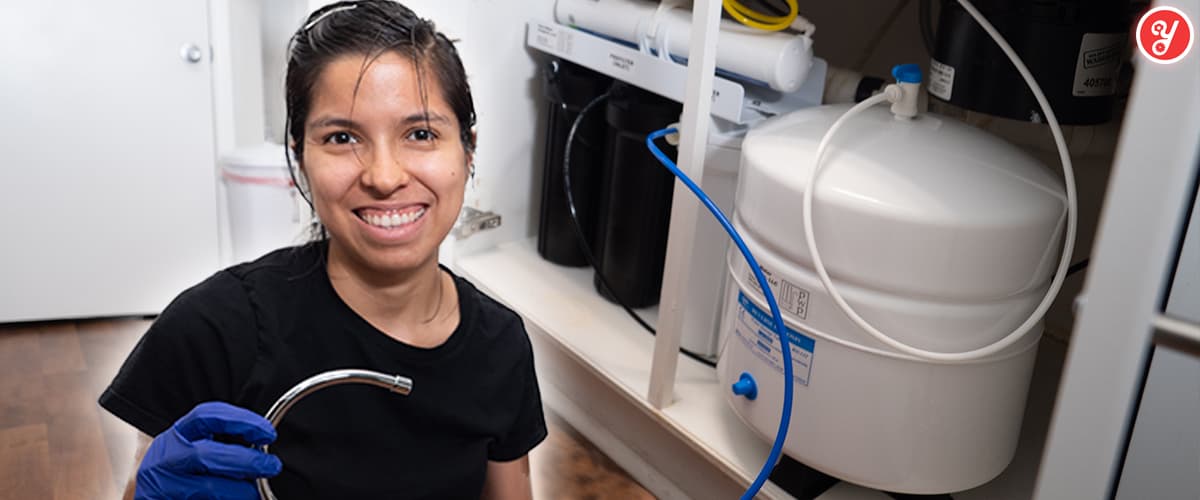



6 Comments
Destiny Calling
Good information about approval on blog commenting sites thank you for sharing .
Sapna Krishnakumar
Hello!
This is Sapna and I have filled the application for Fall 2021. Your post mentions being proactive and following up with NASA. Could you give me an email id for the same. To clarify, after filling the application we don’t receive a confirmation right?
Also will the internship be offered only based on the projects I have selected? If they have other openings that fit my profile will I be given those if selected?
Sapna Krishnakumar
I also did not find a section asking me for a letter of recommendation. Also, how do we contact specific mentors or the internship division at NASA? I don’t see a list anywhere.
Joshua Vasquez
Hello,
My name is Joshua and I was wondering if they have changed up on how to get a POC for NASA Internships? I can’t seem to find the mentor who posted up the intern opportunity. I tried connecting with hiring recruiters on LinkedIn but there seems to only be 2 hiring recruiters. I left them a message but haven’t heard back yet. I used the template that was used in the forum. people.nasa.gov doesn’t want to work for me and I can’t figure out the names of people I want to find for the internship. Let me know what you think!
Thanks,
Joshua Vasquez
Aida Yoguely
Hi there Joshua, they probably still use the same system of one POC per space center, and internship program. They just recently cleaned up their websites to hide this information from the public. So yes, it will be harder to look up POCs online. An alternative strategy is to be involved in educational programs that NASA likes, and start building your networking connections from there.
Jessica Xhumari
I’ve searched and asked many many different interns for advice on applying to NASA interns and this by far is the most helpful thing I have found after a year of inquiring. Thank you so much!